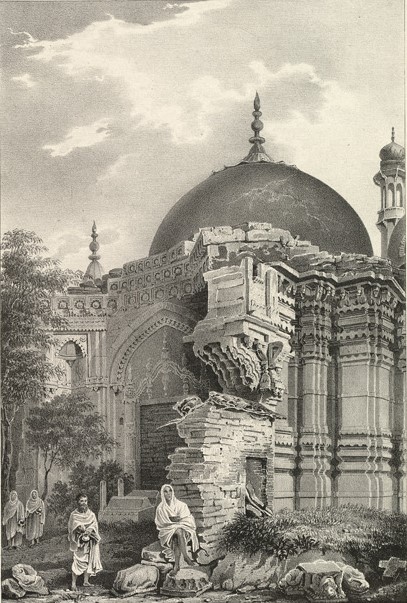By Soumitra Dabholkar

As a corollary to the mention in the article on Ayōdhyā, which described the role of the Marāṭhās in reclaiming and rebuilding sacred shrines of significance to the Hindu faith, would arise a question: why the Marāṭhās, in spite of being the greatest power and determinants of political authority in 18th century India, did not liberate and restore the Kāśī Viśwanātha temple by removing the offending Islamic structure, Gyānvāpī mosque, built on top of it by Islamic iconoclasts after demolishing the original structure? The answer to this can be found in the complicated geopolitical situation that prevailed in India at that time, which the author explains in the following write-up that appeared originally here. Read on to know what these constraining factors were.

Liberating the holy cities of Kāśī, Prayāga and Ayōdhyā and rebuilding the destroyed temples there was one of the key objectives of the Marāṭhās. Despite decades of warfare, politics and diplomacy, these aims remained to quite an extent unrealized and the task of reconstruction unfinished. It is natural to wonder why the Marāṭhās did not just take an army, cross the Ganges and pull down the Gyānvāpī mosque and reconstruct the temple. In fact, on multiple occasions, they thought of exactly this and were very close to doing so. But they faced a much bigger difficulty.
It was the year 1751. The month of April had been an especially happy one for the Marāṭhās. Just towards the end of the month, they had achieved a splendid victory over the Rohilla Pathans in the Gangetic Doab. The news of this victory resulted in jubilation across Maharashtra. The Peshwa, Balaji Baji Rao, showered unrestrained praise on his generals Malharrao Holkar and Jayappa Scindia for delivering a phenomenal victory.
Noted historian G. S. Sardesai writes:
“The object of the Marathas in all these undertakings was both religious and political. They particularly intended to get the holy places of Prayag and Kashi back into Hindu possession...”
On June 18, a Marāṭhā agent wrote in an important despatch to the Peshwa:
“Malharrao has pitched his monsoon camp in the Doab. He intended to pull down the grand Masjid built by Aurangzeb at Benares and restore the original temple of Kashi Vishveshwar. The Brahmans of Kashi feel extremely terrified at such a move for they realise the Muslim strength in these places. What the holy Ganges and protector Vishveshwar can ordain will come true. The Brahmans are going to send strong appeal to the Peshwa against any such attempt by his Sardars.”
This however was not the first time the Marāṭhās chose not to pull down the mosque at Kāśī.
Even earlier in 1743, the Peshwa had been on a pilgrimage to Prayāga and Kāśī of which a Marāṭhī news writer has left behind a detailed account:
“The Shrimant has advanced from Bundelkhand to this place with the object of proceeding to the territory of Patna. He had a holy bath along with his whole following of 75 thousand at Triveni near the Allahabad fort. The boats were provided by the Muslim Subadar of the place. What a wonderful achievement never before attempted by anybody else, for such a concourse to have a successful pilgrimage thus attaining the highest bliss of life. God is great.”
Sardesai further narrates:
“From Allahabad the Peshwa proceeded to Benaras, to which place he paid a hurried private visit simply for taking a bath in the holy waters, wisely refraining from constructing the famous temple.”
Where was the wisdom in choosing not to reconstruct the temple?
Indeed, the liberation of Kāśī Viśweśvara was not going to happen without cost. It involved expending huge human and psychological resources that the Marāṭhās were unwilling to bear at that time.

Demolishing the mosque would have unleashed waves of religious fanaticism throughout India, and particularly in Awadh—after the Marāṭhās would have departed. The Nawab of Awadh remained one of the strongest satellites among the vestiges of decayed Mughal power, and even if he would not have dared create trouble himself—as he was a protégé of the Marāṭhās—he was certain to have found ways and means to effect mischief.
Verily the local people feared retaliation if any attempt was made to reconstruct the temple (which for obvious reasons necessitated demolition of the existing mosque).
The brāhmañas of Kāśī were petrified at the prospect of this move as they realised that Muslim strength in these places was too great and the retribution against the Hindus would no doubt have been huge. It was out of concern for the local populace and to avoid unnecessary warfare that the Marāṭhās decided at that time to relinquish the option of demolishing the mosque.
What happened after this?
This did not however mean that the dream for liberation was forgone. Throughout the 18th century, the Marāṭhās kept up the struggle of liberating the three holy cities of central importance to the Hindus. There is a large body of correspondence available that bear testimony to the fact that the Marāṭhās were unremitting in negotiations to pressurise the Nawab of Awadh to cede the holy cities to them.
Peshwa Balaji Rao’s letters are replete with expressions of his ardent desire and intentions to liberate Kāśī and Prayāga.
“… Najib Khan must be punished. The work in Bengal is also important… one can take Shuja (Nawab of Awadh) with a large army, liberate Patna and Bengal [then under English control]. Take the wazir with you. From Shuja, take Kashi and Prayag. Secure Lahore. Obtain funds to retire the government debt.”
In 1771, the Marāṭhās forced the Mughal emperor to formally cede the districts of Kōrā and Allāhābād (which had the cities of Kāśī and Prayāga) to them. An invasion of Awadh was planned to secure the holy cities.
But the geopolitics of those times severely constrained the Marāṭhās—these two districts initially belonged to the Nawab of Awadh and after the Battle of Buxar in 1764, these were largely protected by British arms, though on paper ceded to Marāṭhās in 1771.
The British policy was to systematically exclude the Marāṭhās from possessing the holy cities, but at the same time use them as a bait in negotiations—and ensure that pilgrimage from the Marāṭhā dominions is encouraged and goes on unhampered. A Marāṭhā victory in Battle of Panipat in 1761 would surely have upturned the hostile geopolitical circumstances. The Marāṭhā contribution to Varanasi has still been immense. Most of the temples and ghāṭs in Vārāñasi today were (re)constructed by the Marāṭhās in the 18th century.
Further, a Kāśī Viśwanātha temple was constructed adjacent to the original site towards late 18th century by the efforts of Ahilyabai Holkar (the Marāṭhā provincial satrap of Malwa) and the worship of Kāśī Viśwevśara revived.
Cover Picture:
Kāśī Viśwanātha Temple, ca. 1915 (Source: Wiki)
References:
- New History of the Marathas, G. S. Sardesai
- The Marathas in the ‘Land of Five Rivers’, Uday S. Kulkarni
